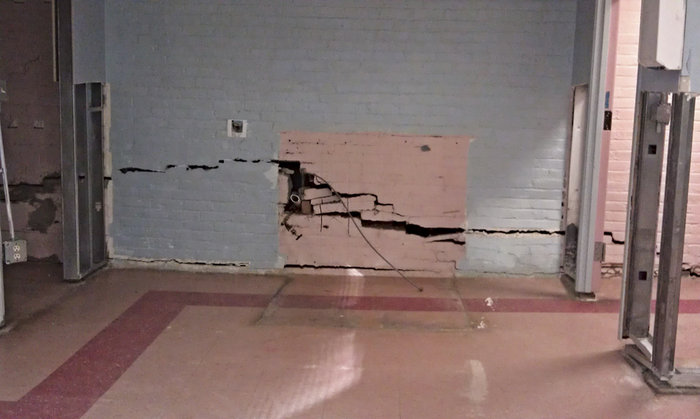Superintendent of Schools Dr. Mark Toback offered a look inside the storm-ravaged basement and cafeteria of the T.G. Connors School last week, as damage and repair efforts that have temporarily driven children who used to attend the Pre-K classes to another school in the city.
The Jan. 27 Reporter featured a story on the Hurricane Sandy-displaced children and a group of very upset parents, some of whom have been walking a round trip of four miles per day to tote their little ones to interim classrooms at Brandt School.
Some of those parents have asked the school system for a bus, but school officials have said state school transportation regulations require a greater distance to make that possible.
Other parents simply asked for transparency on the progress of Connors School and said the district has not been forthcoming enough with information.
The estimated damage is between $600,000 and $700,000, Toback said. After the floodwaters receded and the floors were taken up, many more issues were revealed, some which may have been pre-storm but which now must be part of the repairs.
What was lost?
Connors School, at 201 Monroe St., was the worst hit school in the district during the superstorm. It is located in the 4th Ward, in the southwest end of the city that regularly floods even during a heavy rain storm, much less a hurricane. The basement, which housed the cafeteria and classrooms for the state-funded pre-K program HOPES, was destroyed by flooding and is in the process of being entirely rebuilt.
No definitive time frame was set for the rehab. Early on, school officials believed it would be ready by now.
The pre-K children were directed to Brandt School, which is located at Ninth and Garden streets, a long walk for parents who live near Connors.
“We try to look at it as though these are our own kids.” – Mark Toback
“It takes a long time to get to the point where things are clean, before you can even begin the rest of the work,” said Toback. “The custodians also worked around the clock.”
First there was an extensive clean up. Many items had to be either salvaged and cleaned or otherwise removed. Boxes of items that were too high for the flood waters to destroy lined the perimeter of the classrooms.
Twana Bell, a custodian at Connors who worked day in and day out after Sandy, said, “We’re getting there. We are finally getting rid of all of that stuff.”
What was found?
After the clean-up, school officials discovered there was much more to the task of fixing Connors School.
“There were sub floor boards put in years ago over the real floors,” Toback said. “When these were taken up after the storm, other issues began to be revealed.”
About a foot below the sub floor level prior to the storm is sloping ground that sags in the middle. Cracks in the walls, never before seen, were also revealed. Many of these discoveries would not have been made without the flooding, making Hurricane Sandy an ironic blessing in disguise.
“This isn’t a situation where anyone is in danger,” said Toback. “The damage isn’t structural. However, five years down the road or ten years down the road, these could be issues. The district needs to evaluate the proper fix, not just cover it up. These issues need to be looked at. We try to look at it as though these are our own kids,”
On top of the newly found deficiencies, all of the cafeteria equipment was wiped out.
“Electrical panels had to be replaced, inspections needed to be conducted as well as air quality and mold testing,” explained Toback.
A long row of plastic-wrapped appliances, recently delivered, stood waiting to be installed.
“We are still not going to be able to cook down here, but we will have a company start delivering food,” said Toback. “It’s a drag for these students to eat in their classrooms, and it is very tough on the custodial staff as well as the teachers.”
Going forward
Some parents of the HOPES pre-K children felt that Connors School was being discriminated against.
“In some respects, we have taken these children under our wing,” Toback said. “We have done an awful lot to make this school equal to other schools in the district. They didn’t have science labs or a playground. Now there are working science labs upstairs and a playground.”
On behalf of the parents who must travel long distances to bring their children to school at Brandt, Toback has spoken to the county superintendent of schools and the school board attorney. Thus far, they haven’t suggested anything he can do to transport the displaced children.
While the district can provide bussing for sports and extra-curricular activities, Toback said, these after-school activities are covered by different regulations. State law requires a two mile, one-way distance between home and school before transportation can be legally provided.
A call seeking comment from HOPES program officials was not returned.
Amanda Palasciano may be reached at amandap@hudsonreporter.com.
